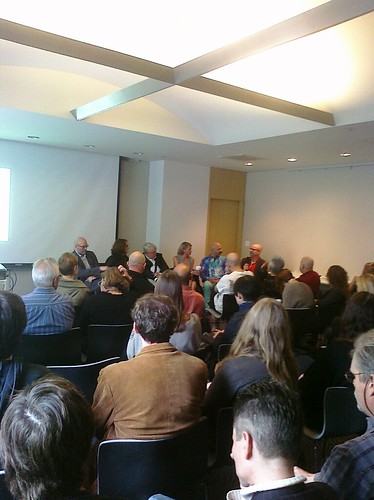I was at ybca, because I've come ot know and really respect Catharine Clark. I got to know Catharine, because Ken Goldberg is doing an installation at the CJM to be entitled Are We There Yet? And Catharine represents Ken's work through the Catharine Clark Gallery.
Initial funding for Are We There Yet? came in the form of one of those amazing collaborative grants from the Creative Work Fund. According to the Creative Work Fund web site, four principles guide the Fund:
How fantastic is that?!

Well, anyhow, as part of getting to know Catharine Clark, she tells me she's going to be on a panel with collectors Jeff Dauber and Dennis Scholl about digital art, which I later discover is to be moderated by Richard Rinehart, Digital Media Director & Adjunct Curator at the Berkeley Art Museum and Pacific Film Archive and that Lynn Hershman Leeson is going to be a part of it as well. Rounding out the participants is Jason Kaufman, Chief US Correspondent for The Art Newspaper.
The history of computer-based art practice goes back to at least the 1968 Cybernetic Serendipity exhibition at the ICA in London, yet digital art is only now starting to attract the attention of collectors in greater numbers. Digital art milestones such as; Listening Post by Ben Rubin and Mark Hansen, the thrilling public spectacles of Rafael Lozano-Hemmer, and the break-through LED works of Jim Campbell have been collected by a few pioneer institutions and brave individuals, but these works and others like them can be daunting to collectors. They present new and unusual technical, legal, and maintenance obstacles that can inhibit collectors and thus the market and thus support for a whole class of artists.
The collectors echoed beautifully the kind of thinking articulated in the Creative Work Fund's four guiding principles. Scholl talked about his support of the work of Paul Pfeiffer. Catharine Clark talked about Nina Katchadourian's Talking Popcorn, which apparently caught fire in one installation. What do you do about that? And Scholl went on to add how the Linda Pace Foundation, on whose Board he sits, is an essential sustainer of the work of Isaac Julien, and how essential that support is.
A really lively and beautiful dialogue ensued, especially to hear explorations into the heart of what digital art is -- how much it is or isn't like it's own documentation, or its own "liveness," as Lynn Hershman Leeson put it, or how much it needs remain part of its initial technical makeup, and whether it need have residual object value beyond the validity of the technology.
 I kept thinking about all those lost-object black-and-whites from art history books, the lost Lorenzo Lotto, or others often lost to wars (now being reclaimed and repatriated in some cases rediscovered and redocumented, thanks to new digital inventories) and how much that work is so much no longer what it was when first made. Yet these predella panels, paintings or objects still hold an important historical and aesthetic position. With time, they have also taken on a conceptual stance well beyond original intentions, and maybe even quite contrary to the original context, being re-placed into a seemingly heretical world.
I kept thinking about all those lost-object black-and-whites from art history books, the lost Lorenzo Lotto, or others often lost to wars (now being reclaimed and repatriated in some cases rediscovered and redocumented, thanks to new digital inventories) and how much that work is so much no longer what it was when first made. Yet these predella panels, paintings or objects still hold an important historical and aesthetic position. With time, they have also taken on a conceptual stance well beyond original intentions, and maybe even quite contrary to the original context, being re-placed into a seemingly heretical world.I also thought of the Maestà of Duccio, once heralded in Siena as unique and powerful, magically religious even, now many of the panels are distributed or lost. But each component piece, when you come across it talks back to its source.
What's the technological biosphere that keeps all this going? Audience member Michael Naimark had the next to last word, thanks to Rick Rinehart, and he pointed out that he "wrote the report," and it's called "Truth, Beauty, Freedom, and Money:
Technology-Based Art and the Dynamics of Sustainability." (2003)
The whole talk was part of 01SJ Biennial: 01sj.org/2010/events/collecting-the-impossible/

Comments